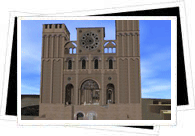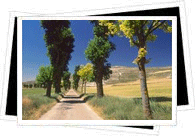 Way of Saint James History
Way of Saint James History If you find yourself travelling around northern Spain, you're likely to pass more than a few sunburnt walkers bearing backpacks, wooden walking sticks and scallop shells. Unless they just like the get-up, chances are that they are pilgrims on their way across the medieval Camino de Santiago (Way of Saint James). Setting out from a variety of starting points and distances, their goal brings them all together in the world's most visited Christian shrine: the Galician city of Santiago de Compostela.
There, you'll find the awe-inspiring cathedral that is said to house Saint James remains, which - according to legend - miraculously made their way from Jerusalem to Galicia by boat following his rather unfortunate beheading. The remains were largely forgotten for hundreds of years, until they were allegedly rediscovered in the early 9th century by a hermit wandering about the hills on his way back to his hermitage. Word eventually got to King Alfonso II, who didn't take long to order the construction of a cathedral as a shrine to commemorate the saint.
In the more than 1,000 years since the pilgrimage's earliest days, people of all walks of life - from rural hopefuls to Spanish royalty and big names like Shirley Mclaine - have taken to the ancient route, usually as a question of faith. Believing in the power of Saint James, word on the street was that upon completion of the journey their time in purgatory was automatically cut in half.
 Way of Saint James Today
Way of Saint James Today Over the past couple of decades, the Way of Saint James - which was essentially the world's first large scale tourist route and about which the world's first "travel guide" was written by a 10th century monk - has seen a huge resurgence of popularity. So many people have traipsed their way to Santiago de Compostela that a popular nickname for the Milky Way is El Camingo de Santiago (Way of Saint James), as legend had it that it was composed of the dust kicked up by the hoards of pilgrims.
If you opt to travel the entire route, be prepared to dedicate about a month to the trek, and that is at a speed of about 30 kilometers per day. The most common route consists of 31 stages, starts out in France, crosses the Pyrenees and then makes its way across Spain. Make sure to travel with your "credencial," a passport-like document which allows you overnight accommodation in the "refugios" along the route, and is necessary if you want to get a Way of Saint James certificate upon your arrival in Santiago de Compostela, as it serves as proof that you've walked at least 100 kilometers (or biked at least 200).
At the end of your journey, be sure to glace at the pillar outside of the doorway. So many pilgrims have laid their hands upon the pillar over the centuries upon their long-awaited arrival that a groove has slowly formed in the stone.
For more, check out the official Way of Saint James website (www.caminosantiago.org) or Santiago de Compostela's official tourism website (www.santiagoturismo.com), both of which have tons of information.